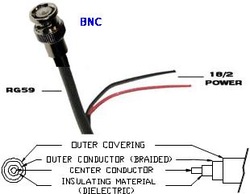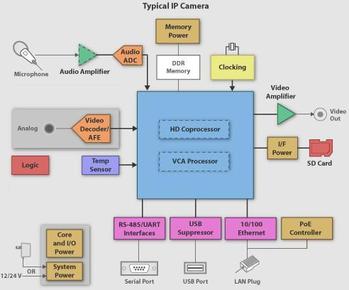Problems with Wireless Solutions
ANALOG CAMERAS
Wireless analog cameras provide different concerns than do digital (or IP) cameras. One of the primary benefits of IP (Internet Protocol) cameras is the relative simplicity of transmitting their output wirelessly or across long distances in a wired environment. Analog cameras are not quite so fortunate.
Wireless analog cameras provide different concerns than do digital (or IP) cameras. One of the primary benefits of IP (Internet Protocol) cameras is the relative simplicity of transmitting their output wirelessly or across long distances in a wired environment. Analog cameras are not quite so fortunate.
Understanding the Problem

Analog cameras are wired via coaxial cable (pictured left) and are terminated with BNC connectors.
Coax cable has limited transmission capabilities - in terms of distance.
One solution to coaxial cable limitations is to transmit the video over CAT-5e or CAT-6 (Ethernet) cable.
Coax cable has limited transmission capabilities - in terms of distance.
One solution to coaxial cable limitations is to transmit the video over CAT-5e or CAT-6 (Ethernet) cable.
That's Been Done...

...and video baluns (devices that switch video signals from one wiring scheme to another) work great!
But that still doesn't migrate analog video through the air wirelessly.
But that still doesn't migrate analog video through the air wirelessly.
So the Solution for Wireless Analog Transmission...

...is a pair of devices (one on the camera end and one on the DVR end) that both require power (i.e. not entirely wireless) but actually do succeed in communicating the analog signal wirelessly.
There are TWO (2) PROBLEMS inherent with analog wireless transceivers...
There are TWO (2) PROBLEMS inherent with analog wireless transceivers...
1. Most operate at on a frequency +/- 20Hz about 2.4GHz
bandwidth. This puts them in "frequency competition" with
virtually every other wireless device (cordless phones, printers,
keyboards, walkie-talkies, etc.) - we've even experienced
"noise" from a automobile's keyless entry system - which
renders 2-3 of the available channels worthless.
The video imagery becomes clouded with lines of "electrical
noise" and has no recorded value whatsoever. Those that
operate at the 5.8 GHz bandwidth are few and far between and
are prohibitively expensive (we've used them) - on the order of
$2000 per pair.
Given there are only 4 channels - about the 2.4GHz frequency,
even if the devices worked properly (on all channels) the
system is limited by the number of cameras that can be
transmitted wirelessly.
2. Objects (buildings, trees, light poles, etc.) create interference
(get in the way and prohibit transmission) and or limit
transmission distance. Even when conditions are "ideal," (clear
line of sight with no obstructions) wireless transmission
distance of analog video is limited to (depending upon who you
read) 250-300 feet - 25-50 feet through walls and/or ceilings.
bandwidth. This puts them in "frequency competition" with
virtually every other wireless device (cordless phones, printers,
keyboards, walkie-talkies, etc.) - we've even experienced
"noise" from a automobile's keyless entry system - which
renders 2-3 of the available channels worthless.
The video imagery becomes clouded with lines of "electrical
noise" and has no recorded value whatsoever. Those that
operate at the 5.8 GHz bandwidth are few and far between and
are prohibitively expensive (we've used them) - on the order of
$2000 per pair.
Given there are only 4 channels - about the 2.4GHz frequency,
even if the devices worked properly (on all channels) the
system is limited by the number of cameras that can be
transmitted wirelessly.
2. Objects (buildings, trees, light poles, etc.) create interference
(get in the way and prohibit transmission) and or limit
transmission distance. Even when conditions are "ideal," (clear
line of sight with no obstructions) wireless transmission
distance of analog video is limited to (depending upon who you
read) 250-300 feet - 25-50 feet through walls and/or ceilings.
DIGITAL (IP) CAMERAS

IP are (typically) a combination of analog and digital technology.
The difference (addition) is the encoder (which digitizes the analog signal - allowing trans-
mission from the camera to the recorder via existing IT systems (TCP/IP networks, switches, routers, etc.)
Once the data has been digitized, wireless transmission (via any of the technology existing in the Information Systems world is possible. Since the digital data is in a format that is consistent with the much broader Information Technology Systems marketplace, devices (wired and wireless hardware) are readily available for network video transmission.
Problems which the IP video industry have (for the most part) overcome have more to do with minimizing file size than they have to do with transmission hardware. The advent of Mega-Pixel IP cameras has "created" even larger file sizes and magnified the problems. One issue is to get the video from Point-A to Point-B. It's an entirely new concern when, while doing so, all the rest of a company's network traffic grinds to a snail's pace.
For additional information on IP Cameras CLICK HERE
The difference (addition) is the encoder (which digitizes the analog signal - allowing trans-
mission from the camera to the recorder via existing IT systems (TCP/IP networks, switches, routers, etc.)
Once the data has been digitized, wireless transmission (via any of the technology existing in the Information Systems world is possible. Since the digital data is in a format that is consistent with the much broader Information Technology Systems marketplace, devices (wired and wireless hardware) are readily available for network video transmission.
Problems which the IP video industry have (for the most part) overcome have more to do with minimizing file size than they have to do with transmission hardware. The advent of Mega-Pixel IP cameras has "created" even larger file sizes and magnified the problems. One issue is to get the video from Point-A to Point-B. It's an entirely new concern when, while doing so, all the rest of a company's network traffic grinds to a snail's pace.
For additional information on IP Cameras CLICK HERE
________________________________________________________________
HOME
Wired or Wireless
BACK BUTTON to PREVIOUS PAGE
HOME
Wired or Wireless
BACK BUTTON to PREVIOUS PAGE
